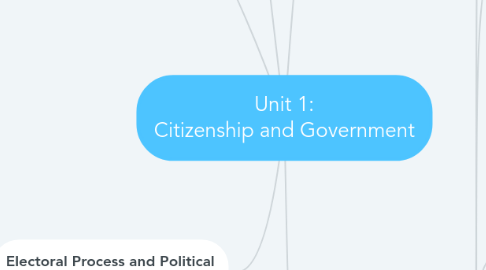
1. Leadership
1.1. Autocratic
1.1.1. A boss who rules absolutely
1.1.2. Does whatever he/she wants
1.2. Democratic
1.2.1. Encourages discussion and respecting other's opinions
1.2.2. Value is placed on the opinions of others
1.3. Laissez-Faire
1.3.1. "Leaves alone" the task of making decisions
1.3.2. Refuses to accept a leadership role
2. Passing Legislation
2.1. Parliament
2.1.1. Legislative branch of the federal government
2.1.2. Made up of the Sovereign, the House of Commons, and the Senate
2.2. Sources of Law
2.2.1. Canadian Constitution (Constitutional Law)
2.2.1.1. Overrides all other laws
2.2.2. Elected Government (Statute Law)
2.2.2.1. Those laws that we are rather familiar with, including the Criminal Code; enacted by both Federal and Provincial government
2.2.2.2. Generally override common law
2.2.3. Previous legal decisions (Common Law)
2.2.3.1. Has its roots in the early unwritten laws of England
2.3. Passing a Law
2.3.1. Government can draft a legislation that addresses public concern; reflects its policies; considers technological advances
2.3.2. If a law is in conflict with the Constitution, then it may be struck down
3. Electoral Process and Political Parties
3.1. Political Spectrum
3.1.1. Communism
3.1.1.1. All property is owned by the country
3.1.2. Socialism
3.1.2.1. The state owns capital and land and uses it to better the wealth of the people
3.1.3. Liberalism
3.1.3.1. Based on the idea that the individual should have rights and civil liberties
3.1.4. Conservatism
3.1.4.1. The idea that we keep traditions and hold on to the past
3.1.5. Fascism
3.1.5.1. Led by a dictator having complete power ; has total control and uses the military to enforce it
3.2. Election Process
3.2.1. "Franchise" (Right to Vote)
3.2.1.1. All citizens over the age of 18 are eligible to vote
3.2.2. Provincial and Federal elections must take place within every 5 years ; Municipal levels must take place every 3 years
3.2.2.1. Elections Canada is the organization responsible for elections at the federal level in Canada
4. Democracy
4.1. Restribution
4.1.1. Punishment that is considered to be morally right and fully deserved
4.1.2. Justice based on vengeance and punishment
4.2. Restitution
4.2.1. The restoration of something lost or stolen to its proper owner
4.2.2. Recompense for injury or loss; essentially means "restoring"
4.3. Democracy is a society in which the authority of the government depends on the consent of the people. Citizens have the opportunity to make decisions with regards to leadership selection, creation of government policies, and the passage of laws
4.3.1. A complex form of self-government that is multi-faceted in meaning, and precious to citizens in a variety of different ways
5. Political Structure
5.1. Making Laws
5.1.1. Laws must be able to meet legal challenges, gain the support of most citizens, be enforceable, and they should balance competing interests
5.2. Constitution
5.2.1. A document setting out the framework for how a country should be governed
5.2.2. Canada's constitution was established in 1867 as an Act of the British Parliament
5.2.3. Before Canada's constitution, the nation was subject to English Law, and governed by Great Britain
5.2.3.1. Most Canadians were content to be a colony of Great Britain until the American Civil War (1861-1864)
5.2.4. On July 1st, 1864, England passed the British North American Act
5.2.4.1. This established Dominion of Canada as a country, and Sir John A. MacDonald became the first Prime Minister
5.3. A Federal System
5.3.1. Canada would have a federal system where the responsibilities for governing would be divided between twp levels of government; central, and provincial
5.3.1.1. Provinces gained authority over MUNICIPAL services, and delegated that responsibility to local governments to deal with local matters; the third level of government
5.3.2. Aboriginal Self-Government
5.3.2.1. Indian bands established under the Indian Act may operate like municipal governments, and have authority to make bylaws that apply to each reserve land
5.4. The British North American Act
5.4.1. It set out rules for how Canada should be governed, and what kind of country it should be
5.4.2. Canada was unable to make its own laws until much later; they had to ask permission from Great Britain
5.4.3. On March 29th, 1867, the BNA Act recognized that Canada was a separate political entity, which prepared the way for the country today
5.5. Law Making
5.5.1. Executive Branch
5.5.1.1. Sets policy, presents budgets to the legislature, proposes legislation, implements laws passed by legislature
5.5.1.2. Includes Prime Minister/Premier, and the members of the cabinet
5.5.2. Legislative Branch
5.5.2.1. Makes the laws
5.5.2.2. Includes members of Parliament/Legislative Assembly, and senators (not in provincial)
5.5.3. Judiciary
5.5.3.1. Acts as an independent third party during legal disputes, and clarifies law
5.5.3.2. Typically includes justices or judges

